|
Report from
Europe
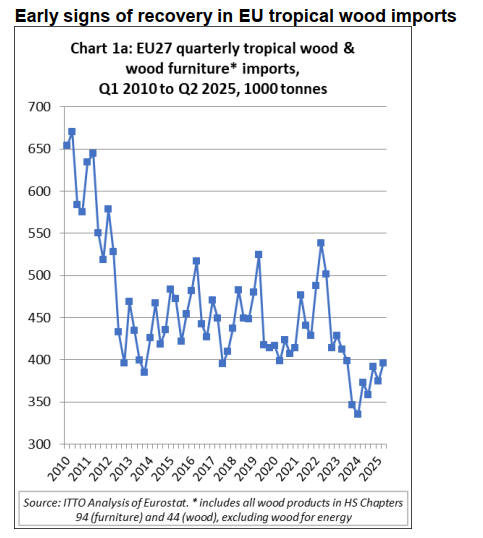
The EU27 imported 770,800 tonnes of tropical wood and
wooden furniturein the first six months of 2025, 9% more
than the same period in 2024 when imports were at an all-
time low. Imports in the second quarter of this year were
396,000 tonnes, 6% more than the previous quarter and
6% more than the same quarter the previous year.
Import tonnage during the second quarter of this year was
still well below the long-term quarterly average of around
450,000 tonnes in the last decade (Chart 1a above).
EU27 import value of tropical wood and wooden
furniturein the first six months of 2025 was US$1663
million, 9% more than the same period in 2024. Import
value in the second quarter this year was US$852 million,
5% more than the previous quarter and 6% more than in
the same quarter in 2024.
In nominal US$ value terms (i.e. not accounting for
inflation), import value during the second quarter of 2025
was well above the pre-pandemic 2013-2019 quarterly
average of around US$750 million (Chart 1b).
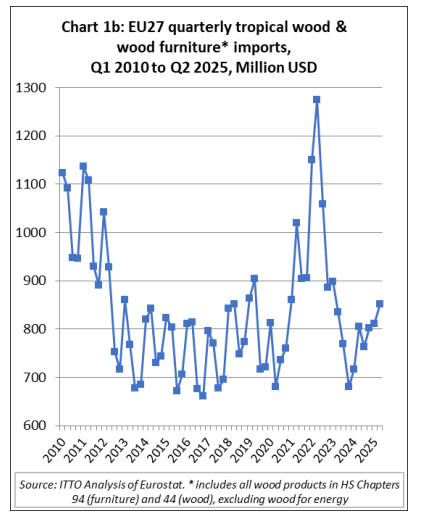
Fragile recovery in EU economy despite political
volatility in France
The faint signs of recovery in EU imports of tropical wood
products align closely with trends in the wider EU
economy.
The economy of the eurozone is growing but, according to
the IMF, only at a forecast 1.0% for 2025 and 1.2% for
2026. The forecast average rate of growth in the zone’s
three largest economies – Germany, France, and Italy – is
just 0.4%.
The economic recovery is fragile and there are continuing
political challenges.
A recent article in the Economist, the UK-based journal,
notes that “on September 8th the French government fell,
owing to disputes about how to close the country’s outsize
budget deficit, prompting its benchmark bond yields to
rise to the level of Italy’s for the first time since the
creation of the euro in 1999.
But there are also positive signals and underlying strengths
to the EU economy. The Economist observes that “the
purchasing managers’ index for European manufacturing,
a widely watched measure, reached a multi-year high in
August. Similarly, Germany’s main sentiment indicator,
the Ifo index, showed business expectations at their
highest since the start of the war in Ukraine.
For its part, Spain’s economy is going from strength to
strength, growing in both manufacturing and services,
according to surveys, helped by high immigration from
Latin America”.
A key reason for the recovery, however fragile, is that
inflation has been almost beaten, at 2.1% in the year to
August, which have allowed interest rates to be reduced.
Consumers have yet to respond with a significant increase
in consumption, but their savings have improved, holding
out the prospect of better times ahead.
The EU private sector is now faring much better than a
decade ago when the bloc was in the throes of the euro
area crisis. Outside of France, private sector debt has
fallen from a peak of 110% of GDP to 95%, the lowest
level in 17 years. Households and corporations are flush
with cash, and debt servicing ratios are healthy across
Europe except in France.
Similarly, European banks have now greatly rebuilt their
balance sheets. Non-performing loans are no longer a
threat, capital and liquidity ratios are robust and
profitability has improved. Germany’s new government
under Chancellor Friedrich Merz has lifted the country’s
debt brake and is embarking on a $1.2 trillion spending
spree focused on defence and infrastructure that is
expected to boost the broader EU economy.
It would be wrong to suggest that these positive trends for
the EU economy yet outweigh the negative impulses.
France’s political crisis may worsen. Export markets are
becoming more challenging in the face of increased tariffs,
slower global economic growth and vigorous competitors.
Structural reforms to the EU economy, seen by policy
makers and economists as essential to boost productivity
growth and the EU’s international competitiveness, are
being rolled only very slowly.
Mario Draghi, the Former Italian PM frustrated with
‘inaction’ a year after preparing an in-depth report for the
European Commission on how to improve Europe’s
competitiveness, told a news conference in September that
“one year on, Europe is ... in a harder place”. Ursula von
der Leyen, the Commission’s president, who asked Draghi
to write the report, admitted that the EU lacked “urgency”
in advancing the competitiveness agenda.
That may be about to change. In addition to measures
designed to improve the functioning of the EU’s single
market, “simplification” has become a watchword of
Ursula von der Leyen’s second term as European
Commission president.
Laws on the environment, agriculture, defence, financial
services, chemicals, artificial intelligence and transport are
all up for “simplification”. Much of it will be done through
so-called omnibus legislation that opens existing EU laws
and strips out anything deemed overly burdensome.
An omnibus bill, first unveiled in February, is now passing
through the EU’s legislative procedures. Right now, the
“simplification” agenda seems to have the upper hand in
the EU, but it is controversial, and the outcome remains
uncertain.
US-EU framework trade agreement promises to diffuse
trade tensions
Another boost to the EU economy may come from the
announcement on 21 August 2025 of the “Joint Statement
on a United States-European Union framework on an
agreement on reciprocal, fair and balanced trade” which
seems, for the time-being, to have diffused trade tensions.
The US agreed to cap the blanket “reciprocal” tariffs on
most EU products at 15% in return for a commitment by
the EU to apply 0% tariff on all US industrial goods.
There is also a joint US-EU commitment to “work
together to reduce or eliminate non-tariff barriers” and to
“enhance opportunities for technical cooperation” on
standards development.
Of particular significance to the forest products sector, the
US-EU framework agreement states with respect to the
EU Deforestation Regulation that the EU “commits to
work to address the concerns of US producers and
exporters… with a view to avoiding undue impact on US-
EU trade”.
Viet Nam and Indonesia drive rise in EU27 tropical
wooden furnitureimports this year
The EU27 imported 168,900 tonnes of wooden
furniturefrom tropical countries with a total value of
US$723 million in the first six months of 2025. Import
quantity and value were up 11% and 13% respectively
compared to the same period in 2024.
In the first six months of 2025, EU27 import value of
wooden furnitureincreased from all major supply countries
including Viet Nam (+19% to US$348.2 million),
Indonesia (+12% to US$180.9 million), India (+4% to
US$128.2 million), Malaysia (+2% to US$45.6 million),
Thailand (+58% to US$11.3 million), and Mexico (+7% to
US$1.8 million). EU27 wooden furnitureimports from the
Philippines were down 1% to US$4.3 million. EU27
wooden furnitureimports from all other tropical countries
were negligible during the quarter (Chart 2).
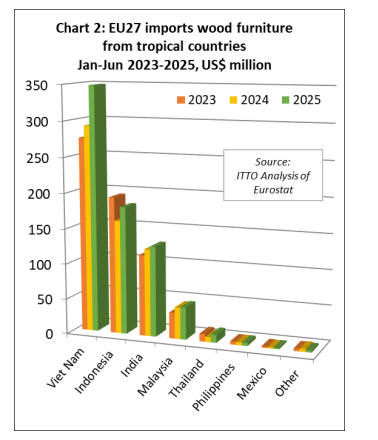
EU27 imports of tropical sawnwood just surpass last
year’s record low
The EU27 imported 356,100 cu.m of tropical sawnwood
with a total value of US$327.2 million in the first six
months of 2025, respectively 2% and 1% more than the
same period in 2024. Tropical sawnwood imports were
down in the first six months of 2025 compared to the same
period last year from Cameroon (-7% to 123,100 cu.m),
the Republic of Congo (-3% to 32,100 cu.m), Malaysia (-
10% to 29,500 cu.m), and Ecuador (-26% to 8,200 cu.m).
However, these declines were offset by rising imports
from Brazil (+28% to 57,800 cu.m), Gabon (+11% to
56,500 cu.m), Ghana (+7% to 8,100 cu.m), the Democratic
Republic of Congo (+65% to 4,200 cu.m), and Indonesia
(+33% to 3,400 cu.m) (Chart 3).
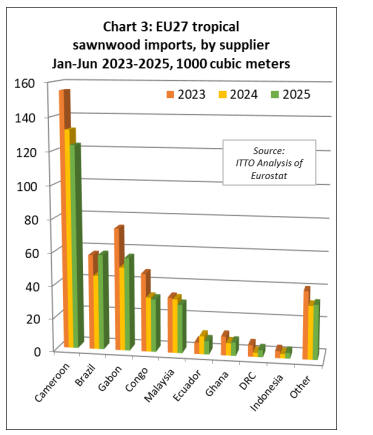
The EU27 imported 60,500 tonnes of tropical
mouldings/decking with a total value of US$103.7 million
in the first six months of 2025, respectively 4% and 6%
less than the same period last year. The decrease in
imports was mainly due to a steep decline from Brazil (-
19% to 18,100 tonnes), and Peru (-65% to 2,400 tonnes).
Imports increased from Indonesia (+27% to 24,400
tonnes), Malaysia (+11% to 3,100 tonnes), and Bolivia
(+13% to 2,800 tonnes). Imports from Gabon were
unchanged compared to last year at 4,300 tonnes (Chart 4).
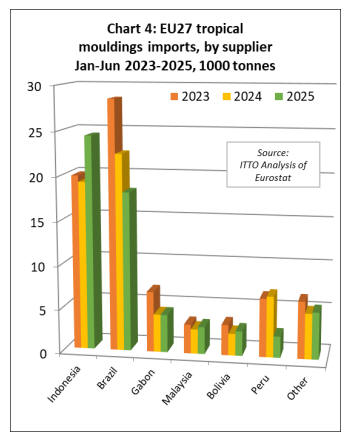
Second quarter rise in EU27 imports of tropical logs
from CAR and Liberia
The EU27 imported 20,900 cu.m of tropical logs with a
total value of US$11.7 million in the first six months of
2025, respectively 5% more and 3% less than the same
period in 2024. The rise in trade quantity was driven by
sharp percentage increases from the Central African
Republic (+52% to 6,500 cu.m) and Liberia (+348% to
1,800 cu.m), concentrated in the second quarter if the year.
Imports from other African countries continued to fall in
the first half of 2025, responding to tighter controls on log
exports. In the first six months of 2025, EU27 log imports
were down from Cameroon (-7% to 2,900 cu.m), the
Democratic Republic of Congo (-39% to 2,700 cu.m), and
the Republic of Congo (-29% to 1,800 cu.m). Logs
imports also fell from Paraguay, by 22% to 2,000 cu.m,
but were stable from Guyana at 700 cu.m (Chart 5).
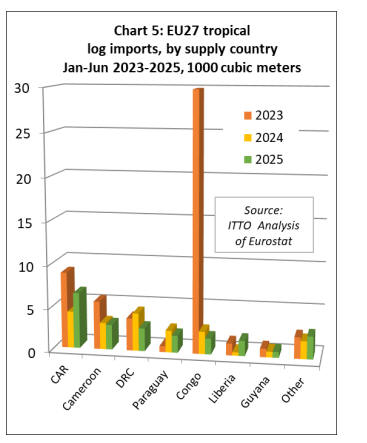
Signs of recovery in EU imports of tropical veneer and
plywood this year
The EU27 imported 125,900 cu.m of tropical veneer with
a total value of US$87.9 million in the first six months of
2025, respectively up 5% and 9% compared to the same
period last year. EU27 imports of tropical veneer increased
during the six month period from Gabon (+1% to 70,000
cu.m), Côte d'Ivoire (+15% to 26,000 cu.m), Cameroon
(+23% to 13,200 cu.m), the UK (+5% to 4,000 cu.m),
Indonesia (+10% to 1,800 cu.m), and Viet Nam (+347% to
800 cu.m).
However, imports of tropical veneer decreased from the
Republic of Congo (-7% to 5,300 cu.m) and Ghana (-3%
to 3,400 cu.m) during the period (Chart 6).
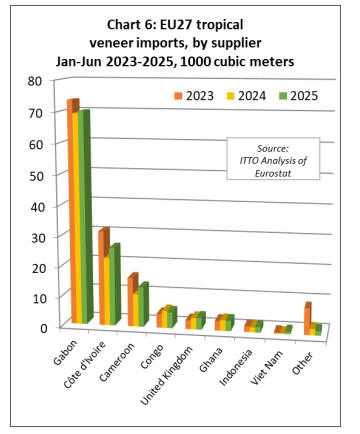
The EU27 imported 150,400 cu.m of tropical plywood
with a total value of US$103.6 million in the first six
months of 2025, up 19% and 13% respectively compared
to the same period in 2024. Imports increased during the
six-month period from Indonesia (+11% to 36,900 cu.m),
Viet Nam (+162% to 29,600 cu.m), Brazil (+49% to
10,700 cu.m), Paraguay (+137% to 8,400 cu.m), Ghana
(+81% to 5,200 cu.m), and Malaysia (+19% to 3,800
cu.m).
However, these gains were partly offset in the first six
months of 2025 by declining imports from Gabon (-3% to
28,800 cu.m), China (-40% to 9,200 cu.m), Morocco (-
10% to 9,000 cu.m), and the UK (-14% to 3,200 cu.m)
(Chart 7).
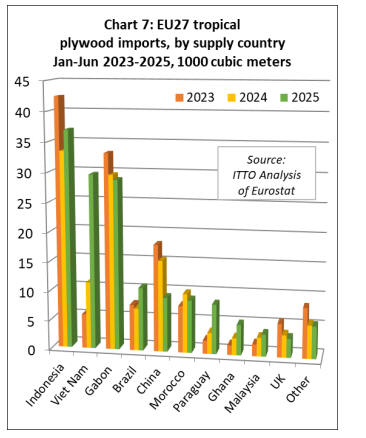
Rebound in EU imports of tropical joinery products
The EU27 imported 14,800 tonnes of tropical wood
flooring with a total value of US$37.5 million in the first
six months of 2025, up 65% and 62% respectively
compared to the same period in 2024. Imports of 5,600
tonnes from Viet Nam in the first six months this year
were nearly 150% more than the same period last year.
Imports also increased by 38% from Malaysia to 5,600
tonnes, recovering in the second quarter after a very slow
start to the year.
EU tropical wood flooring imports have also risen sharply
in percentage terms this year from Indonesia (+27% to
2,100 tonnes), and Thailand (+113% to 400 tonnes).
Imports of tropical wood flooring from Cambodia, near
zero in the first six months of last year, were 500 tonnes in
the same period this year (Chart 9).
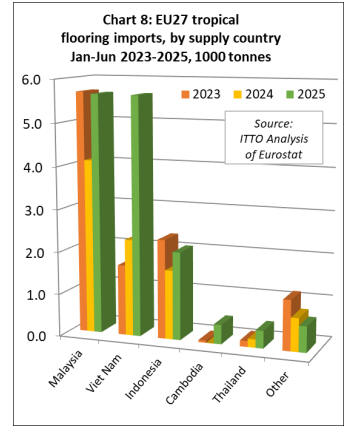
EU27 import value of other joinery products from tropical
countries - mainly laminated window scantlings, kitchen
tops and wood doors – was US$108.4 million in the first
six months of 2025, 18% more than the same period last
year. Import quantity was up 20% to 48,700 tonnes in the
same period. Import value increased from Indonesia
(+28% to US$45.7 million), Malaysia (+12% to US$29.5
million), Viet Nam (+23% to US$10.2 million), the
Republic of Congo (+27% to US$7.8 million), and
Cameroon (+98% to US$3.0 million).
However, EU27 import value of joinery products made
from tropical wood was down 11% to US$2.7 million
from the UK, and down 34% to US$1.1 million from
China (Chart 9).
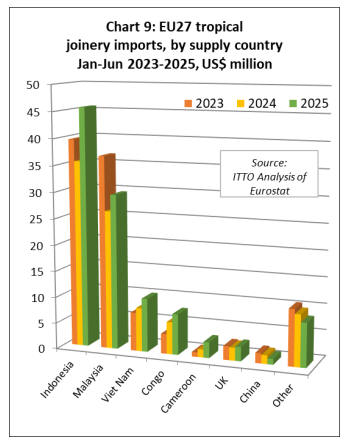
EC proposal to delay EUDR for 12 months
With just over three months until EU Deforestation
Regulation (EUDR) compliance is scheduled to start on 30
December 2025 the European Commission announced it is
considering another one-year delay. On 23 September,
Jessika Roswall, Commissioner for Environment, Water
Resilience and a Competitive Circular Economy, sent
letters to the Parliament and Council indicating that the
Commission’s information system for transactions covered
by the EUDR currently is not expected to be able to
adequately handle all such transactions.
According to Commissioner Roswall’s letter “Based on
the available information, the Commission’s assessment is
that this will very likely lead to the system slowing down
to unacceptable levels or even to repeated and long-lasting
disruptions which would negatively impact companies and
their possibilities to comply with the EUDR.
Operators would be unable to register as economic
operators, introduce their Due Diligence Statements,
retrieve the necessary information from the IT system, or
provide the necessary information for Customs purposes
where relevant. This would severely impact the
achievement of the objectives of EUDR, but also
potentially affect trade flows in the areas covered by the
legislation.”
The letter goes on to suggest that “Despite efforts to
address the issues in time for the entry into application of
the EUDR, it is not possible to have sufficient guarantees
that the IT system will be able to sustain the level of the
expected load.”
The one-year postponement is intended to allow time to
remedy the identified risks. With EUDR compliance
looming the Commission is now expected to quickly
release a “stop the clock” proposal.
To secure quick approval by the Council and it is likely
that the proposal will be limited to timing and will not
seek to address other issues.
See: https://www.euractiv.com/news/eu-set-to-propose-new-
delay-to-anti-deforestation-rules/
|